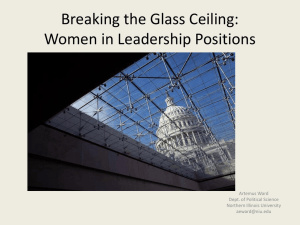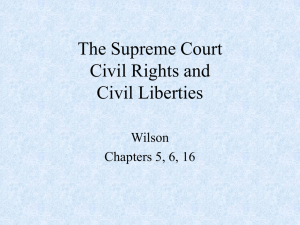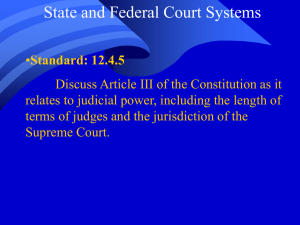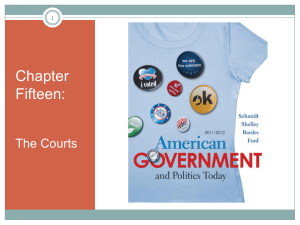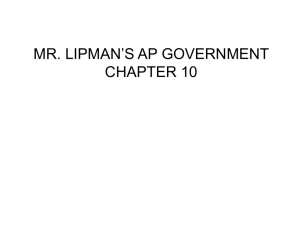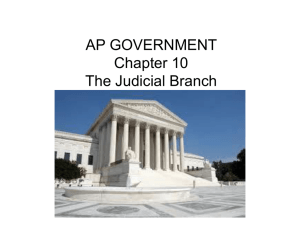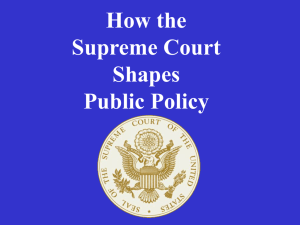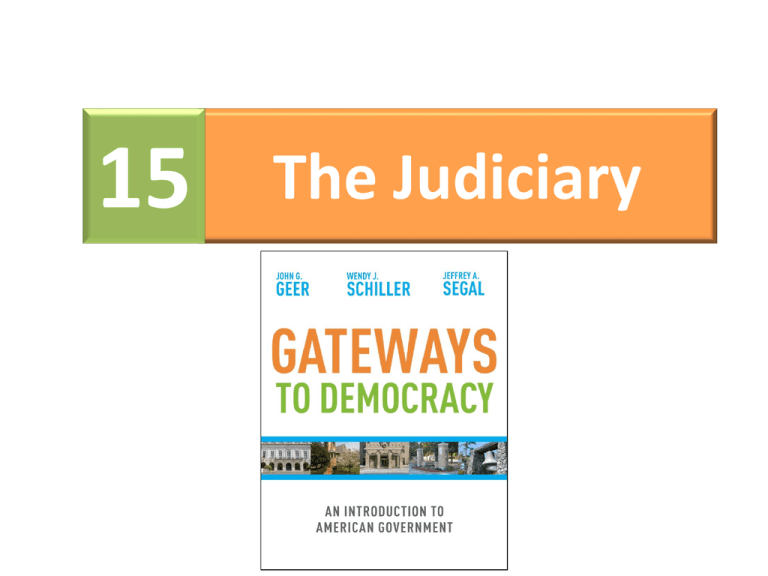
15
The Judiciary
The Judiciary
The job of courts is to resolve legal disputes using the adversarial
system.
• Under an adversarial system, each party presents its version
of events, with virtually all attempts to slant information short
of lying under oath deemed acceptable.
Appeals
If trial courts make mistakes about questions of law, the
American legal system allows for appeals.
• Appeals are heard by appeals courts and by the Supreme
Court.
Types of Disputes
Trials resolve two distinct types of disputes.
• In criminal cases, the government prosecutes an individual for
breaking the law.
• In civil suits, a plaintiff sues a defendant to enforce a right or
to win monetary damages.
– The U.S. Constitution guarantees jury trials in all criminal
cases and in all civil suits over $20.
– Today, Congress limits access to the federal courts in
monetary civil suits to claims of $75,000 or more.
– Suits for lesser amounts must go to state courts.
Criminal Law
Criminal law is based on statutory authority.
• When there are gaps in statutory law, courts rely on judgemade law known as common law.
– Common law requires that judges accept and rely on
previous decisions or precedent.
Article III
Article III of the Constitution and the Judiciary Act of 1789
establish the judicial branch of government.
• Article III briefly refers to a Supreme Court of the United
States and grants Congress the authority to create lower
courts at its discretion.
• The Judiciary Act of 1789 established the structure of the
courts:
– Today there are 94 district courts, 13 circuit courts and 1
Supreme Court.
Jurisdiction
The lawful authority of a court to hear a case is its jurisdiction.
• For the Supreme Court, there are two types of jurisdiction.
– Appellate, which is the authority to hear cases from lower
courts (both state and federal)
– Original, which is the authority to hear the case first.
• The Supreme Court has original jurisdiction in cases
involving foreign dignitaries and disputes between
states.
Judicial Appointments
The Constitution grants the president the authority to nominate
judges, but these nominations are subject to the advice and
consent of the Senate.
• Judges confirmed by the Senate serve during “good behavior,”
or life, unless otherwise removed.
– The Senate established a custom crucial to judicial
independence: that judges would not be removed due to
partisan disagreements with their decisions.
Judicial Review
Constitutional interpretation brings forth the greatest power
of the federal judiciary, judicial review.
• Judicial Review is not found specifically in the Constitution.
• The Supreme Court granted itself the power of judicial
review in the case of Marbury v. Madison (1803).
The Appointment Process
District Courts
• When a vacancy occurs in a district court, the president
selects a nominee, but with awareness of how the senators
from the state in which the court is located might react.
- Presidential staff consult with this state’s senators if they
are members of the president’s party, because if one of
them is opposed, he or she can invoke the norm of
senatorial courtesy and receive the support of other
members of the Senate in blocking that nominee.
- Confirmation of district court judges is generally routine,
with nearly 90 percent of nominees since the Carter
administration (1977–81) approved
The Appointment Process continued
The Court of Appeals
• The formal process is the same as that of district court judges,
but outside interest groups pay closer attention to the nominees.
- Court of appeals judges represent multiple states, seats
“belong to” particular states, so senatorial courtesy still
applies.
- The Senate has failed to confirm more than 20 percent of
court of appeals nominees since Jimmy Carter’s administration.
- In 2010, Senate Republicans began extensive use of holds, a
process by which a single senator can block the unanimous
consent agreements by which the Senate operates, to prevent
votes on many of President Obama’s nominees.
The Appointment Process continued
The Supreme Court
• The appointment of a Supreme Court justice is a high-stakes
affair.
• Often, presidents choose nominees in part because of
perceived electoral advantages.
• Presidents also try to choose nominees who are close to them
ideologically, hoping to shape the direction of the Court.
• In recent times, nominees for the Supreme Court always
receive hearings from the Senate Judiciary Committee.
• There has been a substantial growth in interest group
involvement in Supreme Court nominations
Number of Interest Groups Supporting and
Opposing Supreme Court Nominees
The Appointment Process continued
The Supreme Court (cont.)
Once on the floor, senators debate the pros and cons of the
nominee until the vote is set.
• The votes by senators largely depend on two crucial factors
about the nominees: their perceived ideology and their
perceived qualifications.
– The question of qualifications includes not just ability, but
also ethics.
– Clarence Thomas
• Race, religion and sex also play a role in determining who is
appointed to the Court.
Ideological Distance and Voting for Supreme
Court Nominees
Qualifications and Voting for
Supreme Court Nominees
Judicial Organization
The Courts of Appeals
Above the 94 district courts are the U.S. Courts of Appeals. They
are divided geographically into eleven circuits plus a circuit for
the District of Columbia and a “federal circuit” that hears
appeals from courts that deal with patents and customs.
• The number of judgeships in each circuit ranges from just six
in the First Circuit, to twenty-nine in the Ninth Circuit.
• Regardless of the number of judgeships, the courts usually
hear appeals from the district courts in three-judge panels.
• The courts have mandatory jurisdiction over cases appealed
to it.
U.S. Courts of Appeals and
U.S. District Court
The Supreme Court
Each year, about 8,000 losing litigants ask the Supreme Court
to review their cases.
• The Court’s decision to grant certiorari is purely
discretionary.
• The current Court hears about 100 cases a year.
• Because of the number of cases appealed each year, law
clerks tend to do most of the early reviewing.
The Supreme Court continued
• Discuss list
- list of cases deemed worthy of further discussion
that usually have one of the following characteristics:
• The federal government is the party asking for review
(Solicitor General)
• the case involves conflicts among the circuit court
• the case involves civil rights or civil liberties
• the case is of interest ideologically or politically to the
justices
The Supreme Court continued
• the case has significant social or political interest, as
evidenced by the presence of amicus curiae briefs
» literally means friend of the court
» 3rd party to a lawsuit who files a legal brief for the
purpose of raising additional points of view to
influence the Court
• ACLU
• NAACP
The Supreme Court continued
• The Court grants cert through a rule of four.
– Although five votes constitute a majority, the Court will
agree to hear a case if any four justices vote to grant.
– Overall, the Court grants only about one percent of cert
petitions, leaving the lower court decision as final in the
remaining 99 percent of the cases.
Oral Arguments
Parties normally receive thirty minutes each for oral argument,
although the justices frequently interrupt with questions.
• Oral arguments for the U.S. Supreme Court have recently
become available for the public on the Court’s website within
days after case has been heard.
– http://www.supremecourt.gov/oral_arguments/oral_argu
ments.aspx
The Decision
Within a few days of oral argument, the justices meet in
conference to vote on the merits of the case, that is, to decide
which side wins, and to assign a justice to write the Opinion of
the Court in the case.
• If the chief justice is in the majority, he assigns who writes the
opinion.
• If the chief is not in the majority, the assignment is made by
the senior justice who is in the majority.
• It explains the Court’s justification for its decision and sets
guidelines for other courts to follow in subsequent cases.
Opinions
• Majority opinion: Opinion of a court laying out the official
position of the court in the case.
• Concurring opinion: Opinion by a judge that agrees with the
court majority’s result (that is, which party wins) but sets out
a separate rationale .
• Dissenting opinion: Opinions written by judges who disagree
with the result reached by the majority as to who should win
a case.
• Plurality judgment: Opinion of the court that results when a
majority of the justices cannot agree on the rationale for a
decision.
Impact
The fact that the Supreme Court issues a decision does not
necessarily mean that governmental officials will comply (see
Brown I and II).
• If the decision is based on the meaning of a statute, it can be
overturned by Congress, state legislatures, or through
referenda.
• When the Supreme Court declares something
unconstitutional, legislatures find it difficult to overturn.
• Most Supreme Court decisions are complied with. Following
the Supreme Court’s Watergate decision, President Richard
Nixon turned over the Watergate tapes, even though it meant
the end of his presidency.
The Judiciary and Public Policy
The job of the courts is to interpret the law, but in doing so, they
often appear to go beyond mere interpretation and instead
get actively involved in policy making.
• According to the legal approach, justices base their decisions
on legally relevant materials, such as prior court precedents,
the plain meaning of the text of the law under consideration,
and the intent of the Framers of the law.
The Extralegal Approach
Extralegal factors are those that go beyond the legal factors that
courts are supposed to consider.
• The most important extralegal considerations include the
justices’ own preferences and strategic considerations based
on the preferences of others.
– Justices take into consideration the preferences of their
colleagues, as well as other members of government (the
President).
Ideology of Supreme Court Justices
Activism and Restraint
Given the undemocratic nature of judicial review, politicians
frequently decry judicial activists, judges who go beyond what
the law requires and seek to impose their own policy
preferences on society through their judicial decisions.
• These critics insist that judges should act with judicial restraint,
that is, judges should respect the decisions of other branches, or,
through the concept of precedent, the decisions of earlier
judges.
– Contemporary research suggests that justices respect the
decisions of legislatures and earlier judges when those
decisions are consistent with the justices’ ideology.
Number of Federal Laws Declared
Unconstitutional, 1790–2009
Focus Questions
• Why is the apparently simple requirement of providing “equal
protection of the laws” in fact more difficult than it seems?
• In what ways do the federal courts lack traditional means of
accountability?
• How are courts, nevertheless, responsive?
• Do citizens have equal access to the justice system? Does the
justice system treat them equally?
• Is the judiciary a gate, or a gateway, to democracy?



